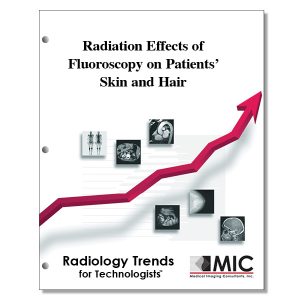-
Radiology Trends for Technologists
Radiation Effects of Fluoroscopy on Patients’ Skin and Hair
A review of the current data concerning the essential factors regarding radiation effects on patients’ skin and hair. Fluoroscopy guided procedures and radiation therapy are discussed.
-
Radiology Trends for Technologists
Radioiodine Scintigraphy with SPECT/CT: Thyroid Cancer
A presentation of SPECT/CT as an important tool for thyroid cancer staging and risk stratification.
-
Radiology Trends for Technologists
Radioiodine Therapy for Thyroid Cancer
Objectives of radioiodine therapy for thyroid cancer are presented, and agents, targets and treatment strategies for iodine-refractory thyroid cancer are discussed.
-
Radiology Trends for Technologists
Radionuclide Imaging in Ischemic Stroke
Radioactive tracers and applications of radioisotope studies in stroke evaluation are presented. Future perspectives using hybrid imaging are discussed.
-
Radiology Trends for Technologists
Radionuclide Imaging in the Surgical Management of Primary Hyperparathyroidism
This review emphasizes the importance of performing imaging before any surgery for primary hyperparathyroidism.
-
Radiology Trends for Technologists
Radionuclide Imaging of Musculoskeletal Infection
A look at the various radiopharmaceuticals used in the diagnostic workup of patients suspected of having musculoskeletal infection.
-
Radiology Trends for Technologists
Reducing Radiation Dose in Radionuclide Myocardial Perfusion Imaging
A practical approach to performing low-radiation-dose myocardial perfusion imaging using traditional and novel technologies.
-
Radiology Trends for Technologists
Small Bowel Obstruction
The pivotal role of radiology in recognizing, classifying and answering specific questions that will directly affect the management of patients with small bowel disease.
-
Radiology Trends for Technologists
SPECT/CT of Radioiodine Biodistributions
The role of SPECT/CT in assessing physiologic uptake of radioiodine, normal variants, and metastatic disease mimics is presented.
-
Radiology Trends for Technologists
SPECT/CT of Spondylolysis in Children and Young Adults
A review of the SPECT/CT assessment of spondylolysis and other causes of low back pain in children and young adults that can be identified at SPECT/CT.
-
Radiology Trends for Technologists
Staging Ovarian Cancer Using FDG PET/CT
A presentation of the role of FDG PET combined with CT plays in depicting recurrent ovarian cancer.
Nuclear Medicine
© Copyright MIC 2023. All Rights Reserved. | web design












